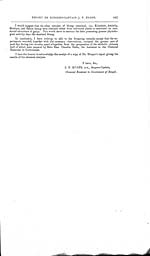Medicine - Drugs > Report of the Indian Hemp Drugs Commission, 1894-1895 > Volume III
(230) Volume 3, Page 226
Thumbnail gallery: Grid view | List view

226 REPORT OF THE INDIAN HEMP DRUGS COMMISSION, 1893-94. [APP.
Experiment No. 154, Gwalior charas.
Male cat, weight 4 lb
21/2 oz.; Dose 5.81 grains at 1-40 P.M. 2-15 P.M., rocking
of
body and staggering, unsteady gait. 3 P.M., very definite symptoms
displayed. 4 P.M., still
under the influence of the drug.
Experiment No. 155, Kumaon charas (cultivated).
Male cat, weight 4 lb
71/2 oz. Dose 6.25 grains at 2-15 P.M. 3 P.M., no apparent
effect. 4 P.M., animal is excited and constantly on the move; no
tendency to sleep; on running
or walking it frequently falls on its side especially on turning
round.
Experiment No. 156, Nepal charas, A.
Female cat, weight 3 lb 6 oz. Dose 4.72 grains at 2-20 P.M. Effect nil.
Experiment No. 157, Nepal charas, B.
Female cat, weight 4 lb 61/2 oz. Dose 6.16 grains at 2-40 P.M. Effect nil.
Experiment No. 158, Nepal charas, Shahjahani.
Male cat, weight 5 lb
21/2 oz. Dose 7.21 grains at 12 noon. Effect nil.
(n) Three experiments with a dose equivalent to 1/2,500 part of
the body weight.
Experiment No. 159, Nepal charas, A.
Female cat, weight 3 lb 2 oz. Dose 8.75 grains at 12-45 P.M. Effect nil.
Experiment No. 160, Nepal charas, B.
Male cat, weight 3 lb 31/4 oz. Dose 8.96 grains at 1-35 P.M. Effect nil.
Experiment No. 161, Nepal charas, Shahjahani.
Male cat, weight 4 lb 41/4 oz. Dose 10.76 grains at 1-30 P.M. Effect nil.
CONCLUDING REMARKS.
The method of testing
samples of hemp drugs by ascertaining their physiological
value
may be regarded as much more satisfactory in the case of ganja and
bhang than in the case
of charas. For it is submitted that ganja and bhang do not lend
themselves so readily
to successful adulteration as charas. Consequently, while the
results of the physiological tests
may be assumed to have a definite comparative value in the case of
the various samples of
ganja and bhang, no such reliable result can be claimed from the
experiments with the samples
of charas.
There are three samples
of charas of which the physiological value has not been
determined,
i.e., the three samples of Nepal charas. For when a dose of
more than ten grains administer-
ed to a cat weighing less than 41/4 lb produced no effects, it did
not appear worth while to
pursue the investigation further. Whether, however, these three
samples are without physio-
logical value due to successful adulteration, or to the absence of
active principle in the ganja
from which they were prepared, I am not in a position to say. To a
varying degree the same
remark applies to all those samples of charas in which the
physiological value of the extract
is much below that of the extract of the standard ganja. Alcohol is
able to extract all the
active principles present in any sample of hemp drugs. It will be
seen on reference to table
No. 1 that the quantity of the alcoholic extract varies greatly,
and that it bears no relation to
the physiological activity of the sample. As already stated this
may be due in the case of charas
to successful adulteration, but this is by no means to the same
extent true in the case of ganja
and bhang.
In order, therefore, to
obtain a true conception of the comparative value of any number
of
samples of ganja and bhang, they should be grouped, not according
to the quantity of the
alcoholic extract, nor yet according to the dose required to
produce minimal effects, but accord-
ing to the quantity of their alcoholic extracts which may be
regarded as physiologically active.
This has been roughly calculated and the results are given in table
No. III. The samples of
bhang yield a smaller percentage quantity of alcoholic extract than
the samples of ganja.
Their alcoholic extract is, in the majority of instances, much less
active physiologically than the
extracts of the samples of ganja. A point of considerable
importance appears to be the great
difference in physiological activity presented by the different
samples of bhang. The doses of
the bhang extracts range from 1/5,000 to 1/100,000 part of the body
weight, a very much wider
range than is presented by the ganja extracts.
The bhang obtained from
cultivated plants is at least four times as active as that
obtain-
ed from wild plants.
The Assam bhang from wild
plants possesses equal activity with the sample of Bhagalpur
bhang obtained from the Board of Revenue and utilised as a
standard.
Set display mode to: Large image | Zoom image | Transcription
Images and transcriptions on this page, including medium image downloads, may be used under the Creative Commons Attribution 4.0 International Licence unless otherwise stated. ![]()
| India Papers > Medicine - Drugs > Report of the Indian Hemp Drugs Commission, 1894-1895 > Volume III > (230) Volume 3, Page 226 |
|---|
| Description | Volume 3: Appendices. Miscellaneous. |
|---|---|
| Attribution and copyright: |
|




